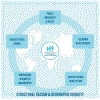The role of structural racism and geographical inequity in diabetes outcomes
- PMID: 37356447
- PMCID: PMC11329296
- DOI: 10.1016/S0140-6736(23)00909-1
The role of structural racism and geographical inequity in diabetes outcomes
Abstract
Diabetes is pervasive, exponentially growing in prevalence, and outpacing most diseases globally. In this Series paper, we use new theoretical frameworks and a narrative review of existing literature to show how structural inequity (structural racism and geographical inequity) has accelerated rates of diabetes disease, morbidity, and mortality globally. We discuss how structural inequity leads to large, fixed differences in key, upstream social determinants of health, which influence downstream social determinants of health and resultant diabetes outcomes in a cascade of widening inequity. We review categories of social determinants of health with known effects on diabetes outcomes, including public awareness and policy, economic development, access to high-quality care, innovations in diabetes management, and sociocultural norms. We also provide regional perspectives, grounded in our theoretical framework, to highlight prominent, real-world challenges.
Copyright © 2023 Elsevier Ltd. All rights reserved.
Conflict of interest statement
Declaration of interests SA is supported by the National Institutes of Health-National Institute of Diabetes and Digestive Kidney Disease (R01DK132302, K23115896, and P30DK111022-07), JDRF, and The Leona M and Harry B Helmsley Charitable Trust. SA receives research devices, but not salary support from Dexcom and Abbott, and is a health-care disparities adviser (on a temporary advisory board role) for Medtronic and Beta Bionics. ANW is supported by the National Institutes of Health-Fogarty International Centre (K43TW010698). ANW declares an honorarium received from Sanofi for serving as a panel member at an educational event on thyroid cancer. JCM receives honorarium from Servier Laboratories for serving on the advisory committee at educational events. LEE and JAC are supported by the National Institutes of Health-National Institute of Diabetes and Digestive Kidney Disease (R01DK118038 and R01DK120861, awarded to LEE; K01DK131319, awarded to JAC). LEE and RJW are supported by the National Institute on Minority Health and Health Disparities (R01MD013826, awarded to LEE and RJW; R01MD017574, awarded to LEE). RJW is supported by the American Diabetes Association (1-19-JDF-075). LM-B is supported by an Australian National Health and Medical Research Council (NHMRC) investigator grant (1194698), and leads projects that are funded by NHMRC, the Australian Department of Health, and the Australian Medical Research Future Fund. All other authors declare no competing interests.
Figures





References
-
- World Health Organization. Global Report on Diabetes. World Health Organization. Geneva; 2016.
-
- Wang H, Li N, Chivese T, Werfalli M, Sun H, Yuen L, et al. IDF Diabetes Atlas: Estimation of Global and Regional Gestational Diabetes Mellitus Prevalence for 2021 by International Association of Diabetes in Pregnancy Study Group’s Criteria. Diabetes Res Clin Pract. 2022. Jan 1;183:109050. - PubMed
Publication types
MeSH terms
Grants and funding
LinkOut - more resources
Full Text Sources
Medical

